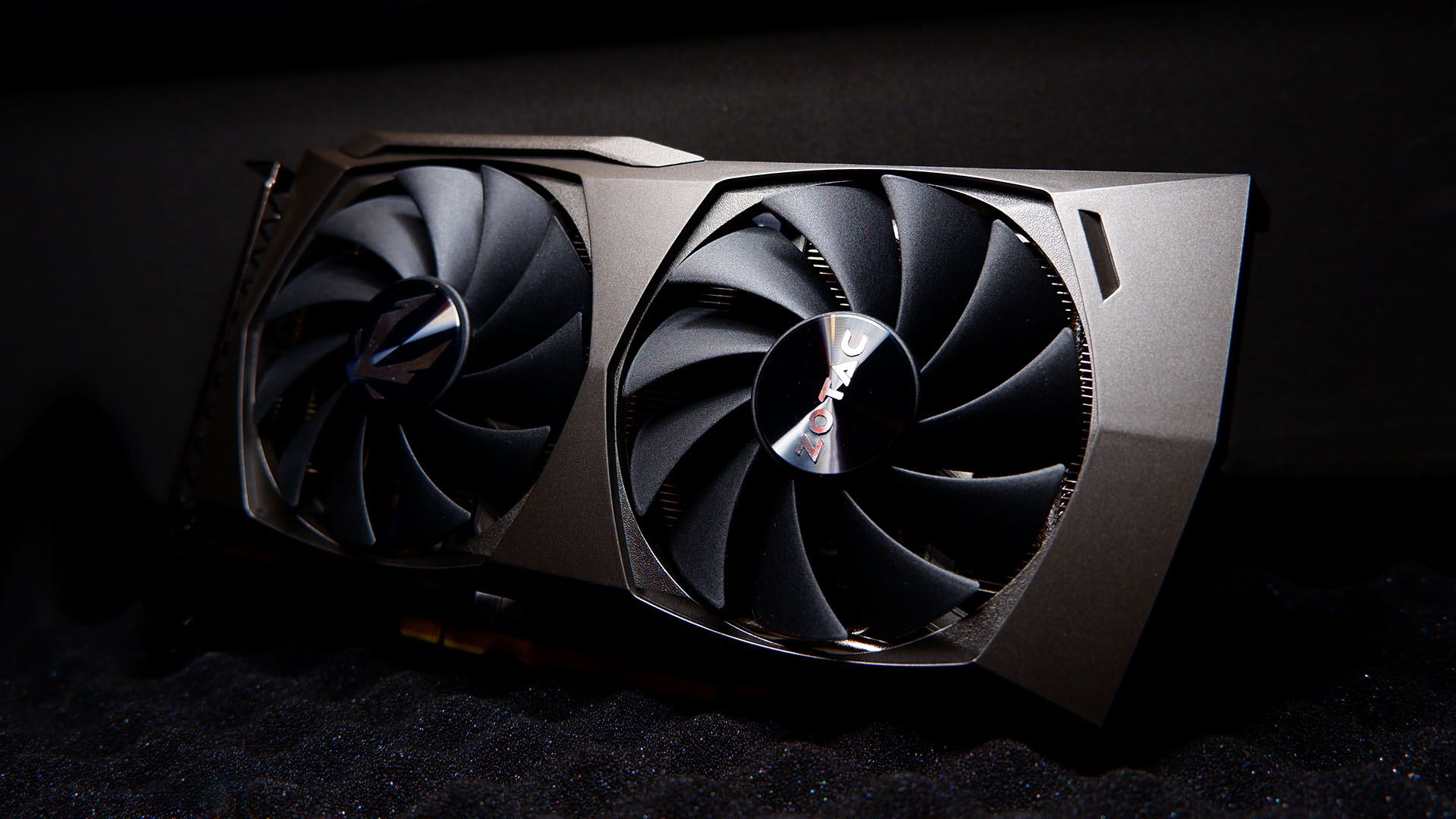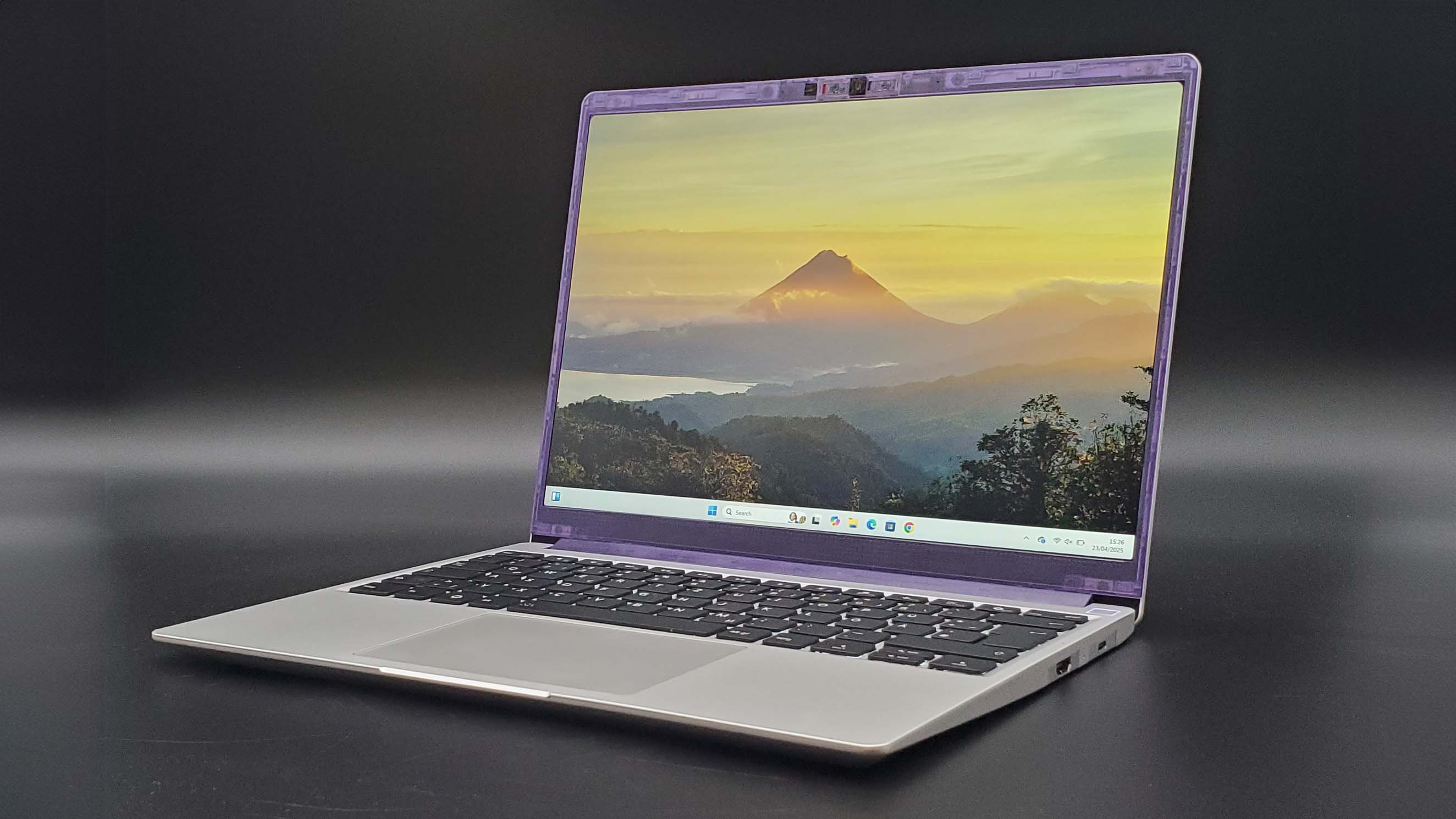Our Verdict
A healthy upgrade over the RTX 2060, but a little of the wow factor has worn off for Ampere's cheapest. You can at least be confident that you won't run out of memory, at least, and that feels like it will be important for gaming into 2021 and beyond, even if we're not quite there yet.
For
- 12GB GDDR6 memory
- Cheaper than RTX 2060 at launch
- Performant Ampere architecture
Against
- Little off the pace for Ampere
- $70 gets you a much faster card in the RTX 3060 Ti
PC Gamer's got your back
At a time when graphics cards are a precious commodity, the Nvidia RTX 3060 12GB will arrive as the cheapest RTX 30-series graphics card to-date. It's destined to swiftly become a best seller… and then sold out in an instant. I'd bet my bottom dollar on it. But while you might expect a cookie cutter launch from Nvidia's fifth Ampere launch to date, you'd perhaps be surprised that the RTX 3060 12GB is something of a new beast altogether.
Perhaps the most newsworthy shake up for the Nvidia RTX 3060 came with the announcement of a hash rate limiter, which will keep the card from operating at its full capability while mining Ethereum, the crypto of choice for GPU mining. Nvidia hopes that'll sway miners towards its new CMP line-up, built from off cut GPUs not fit for gaming consumption, while supposedly leaving more GeForce cards for gamers
But we're not assessing the Nvidia RTX 3060 12GB's mining capability in this review, even if that may have some impact on the eventual availability of these cards. No, we're diving into its gaming prowess. There's a whole new GPU to play with here, alongside a mighty memory loadout, so let's get right to it.
Specifications
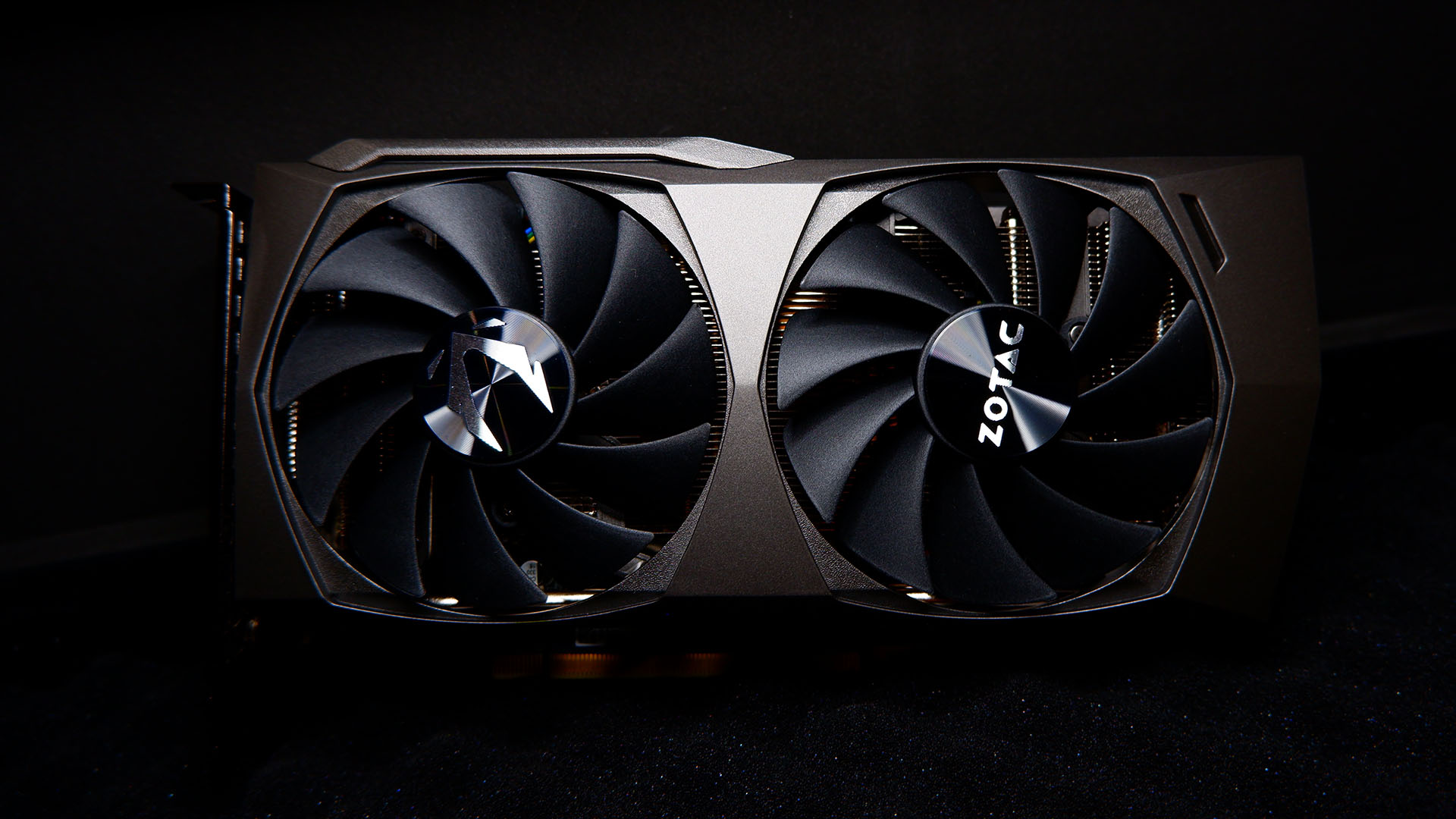
What are the Nvidia RTX 3060 12GB specs?
The Nvidia GeForce RTX 3060 12GB isn't quite what we were first expecting at this price, but that's more down to its engorged memory capacity than its GPU specs.
That 12GB of GDDR6 memory sticks out like a sore thumb from the crowd of RTX 30-series GPUs before it: The RTX 3070 and RTX 3060 Ti both come with 8GB of the stuff, while the RTX 3080 is fit with 10GB of GDDR6X. The chips denoted with that all-important 'X' are actually quite a bit faster than the standard GDDR6 silicon, though, so don't make for direct comparison.
The RTX 3090 is the only RTX 30-series card to top the memory capacity of the RTX 3060, with 24GB of GDDR6X. Again, that's all far quicker in practice. But you can already see why the cheapest Ampere card arriving with the second-highest memory capacity is enough to raise a few eyebrows.
GPU: GA106
Lithograpy: Samsung 8nm
CUDA cores: 3,584
SMs: 28
RT Cores: 28
Tensor Cores: 112
GPU Boost clock: 1,777MHz
Memory bus: 192-bit
Memory capacity: 12GB GDDR6
Memory speed: 15Gbps
Memory bandwidth: 360GB/s
TGP: 170W
MSRP at launch: $329
That's still limited to a 192-bit bus, however, and that means six 32-bit memory controllers on the die. Those can be occupied in either 6GB or 12GB configurations with 8Gb or 16Gb GDDR6 modules from the likes of Micron, Samsung, and SK Hynix.
An 8GB configuration would only be possible with a larger bus, such as the one on the GA104 GPU. That very GPU could be pared back to replace GA106, in theory. Nvidia has done something similar in the past, with the RTX 2060 actually incorporating some pared back TU104 GPUs, and perhaps could be a way to use up unsuitable silicon, but we're far from more than tacit mention of any such configuration today.
I'm not too certain on the specifics of mixing 8Gb and 16Gb modules on the same package either, for an 8GB GA106 card, but that sounds pretty dicey for more than a handful of reasons. A question I need to follow up with an engineer, no doubt.
Let's stick to what we know, and that's 12GB of GDDR6 rated to 15Gbps over a 192-bit bus. That results in slimmer memory bandwidth compared to the other Ampere generation graphics cards at 360GB/s. The RTX 3070 and 3060 Ti manage 448GB/s.
Yet 12GB of memory is welcome at a price of $329, especially considering the RTX 2060 launched for $349 and with just 6GB of GDDR6. And there's plenty to like about the card when you get down to the metal, too.
The GA106 GPU is at the heart of the RTX 3060. It's a brand new chip, silicon not yet seen in our gaming PCs, and that means that the RTX 3060 is in some ways unlike any other Ampere GPU to date.
It touts three GPCs, each one with the potential for up to 10 SMs in total. There's a little redundancy in the actual RTX 3060 chip, though, which comes with two fewer for a total of 28 SMs. Thanks to the advancements in the Ampere architecture, those SMs each carry 128 CUDA Cores, or more precisely 128 potential FP32 units, a piece. Making for an overall CUDA Core count of 3,584.
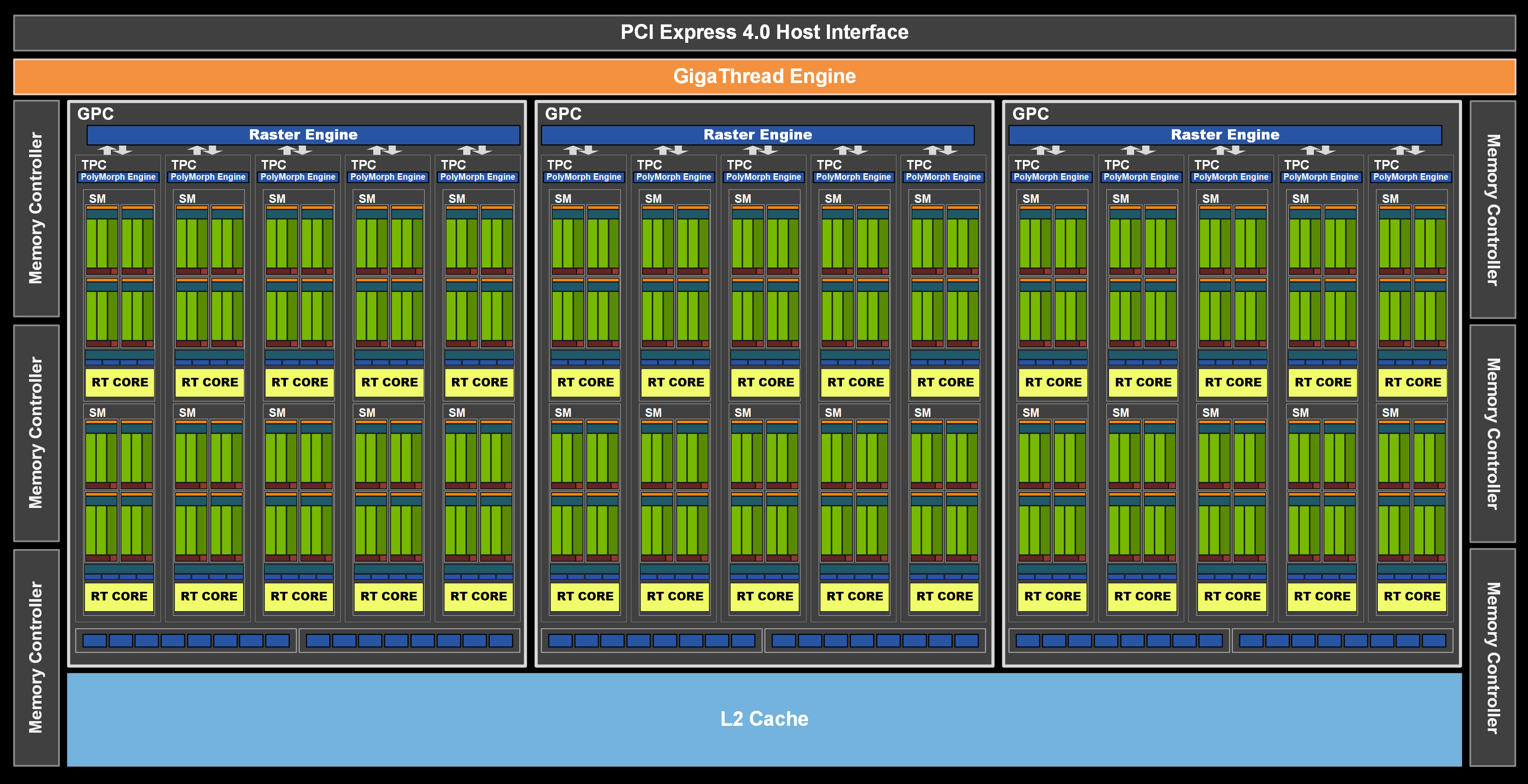
That's significantly higher than the 1,920 CUDA Cores of the RTX 2060, which is our main point of comparison for this review, although it must be said that the way the Ampere generation works doesn't make this a straightforward doubling of performance. It's the FP32 units that are effectively being doubled here, what Nvidia classes as CUDA Cores, while the remaining silicon remains at a close count to its Turing counterpart.
Even the doubling of FP32 units isn't all that simple—the use of a mixed function path that can jump between either integer or floating point tasks is the key to the new core counts all-round. You can see it the Ampere SM diagram, a fixed FP32 unit besides a FP32/INT32 path within each of the four SM processing blocks. Since gaming workloads can vary wildly the flexibility must be there to offer both data paths in good amount, but there's often a leaning towards greater FP32 operations and therefore a boon to performance by offering more capability to crunch those numbers.
So while the RTX 3060 is mightier by CUDA count, it actually has two fewer SMs than the RTX 2060. In terms of ROPs and Texture Units (TMUs), which are both awfully important in building performant graphics cards for today's games, the RTX 3060 comes with 48 and 112, respectively.
The RTX 2060 is a match for ROPs but actually makes up a little ground here with 120 TMUs. It's only a slight boon in writing, but it just goes to show that there's not as much of a difference between the two chips in rendering silicon that the core count may suggest at first glance.
The RTX 3060 also has two fewer RT Cores than the RTX 2060 as a result, too. But don't be mistaken, that does not make it any less capable in ray tracing workloads. In fact, it's notably faster. That's down to the improvements introduced with the second generation RT Cores and third generation Tensor Cores within the Ampere architecture, which have proven mighty for the high-end 30-series in partially negating the burden of ray tracing on frame times.
It's also worth noting that there's no Founders Edition RTX 3060 12GB. The Zotac Twin Edge that we've received for this review is a stock card, though, so you can be sure that you're looking at the jumping off point for all other third-party and factory overclocked cards, of which there are sure to be many.
Benchmarks and performance
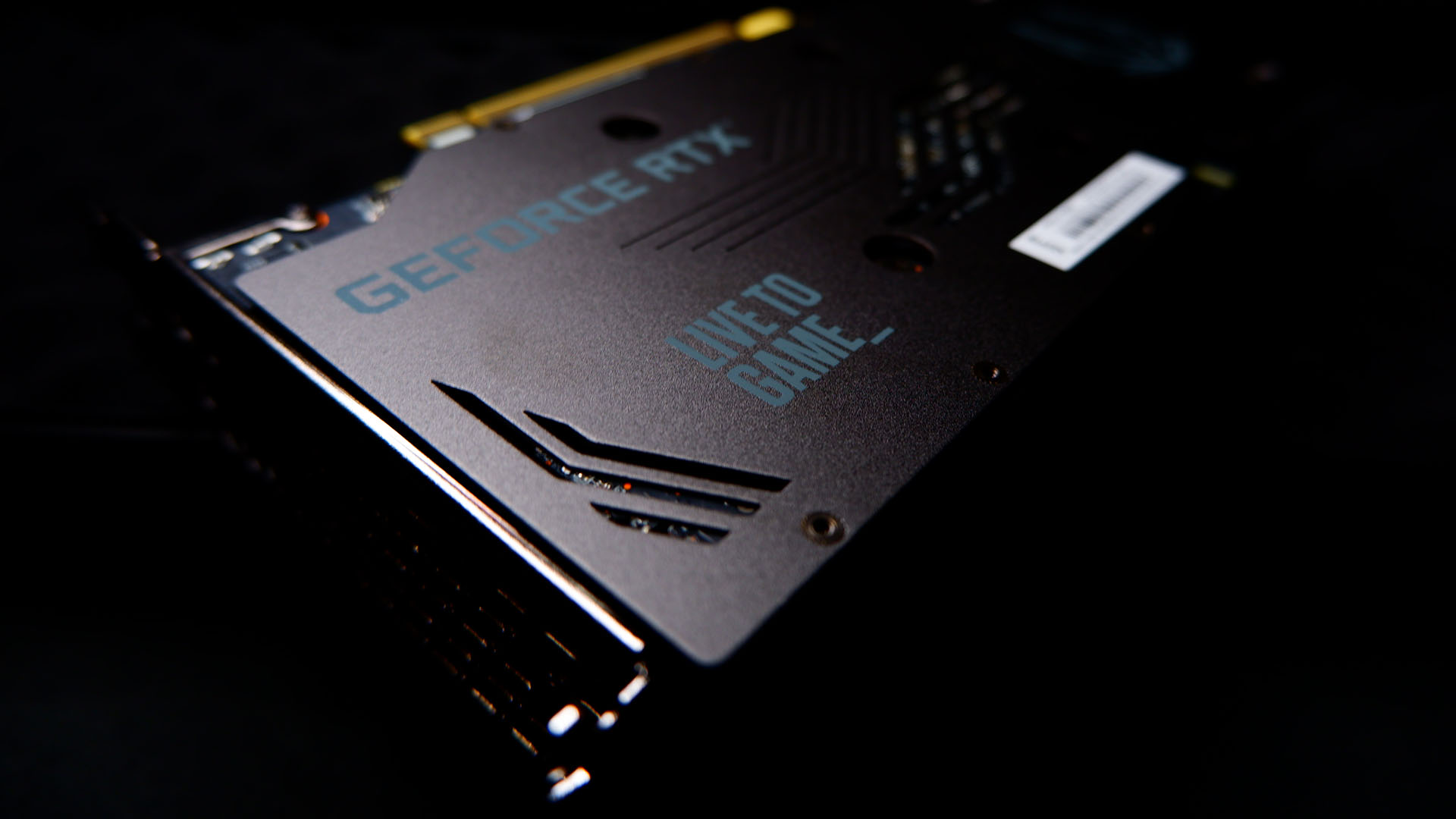
How does the Nvidia RTX 3060 12GB perform?
With a few potentially governing factors in play for performance, you only know what to expect from this card across 1080p, 1440p, and 4K when you hit the graphs.
On the first two counts, 1440p and 1080p, I'm pleased to report that all is well in the green camp. These resolutions are easily within reach for the RTX 3060 across most of our gaming benchmarks, even at highest available graphics settings. We don't expect anything less from even the more entry-level cards nowadays, and so a $329 GPU should absolutely score highly. That it does.
1080p gaming performance
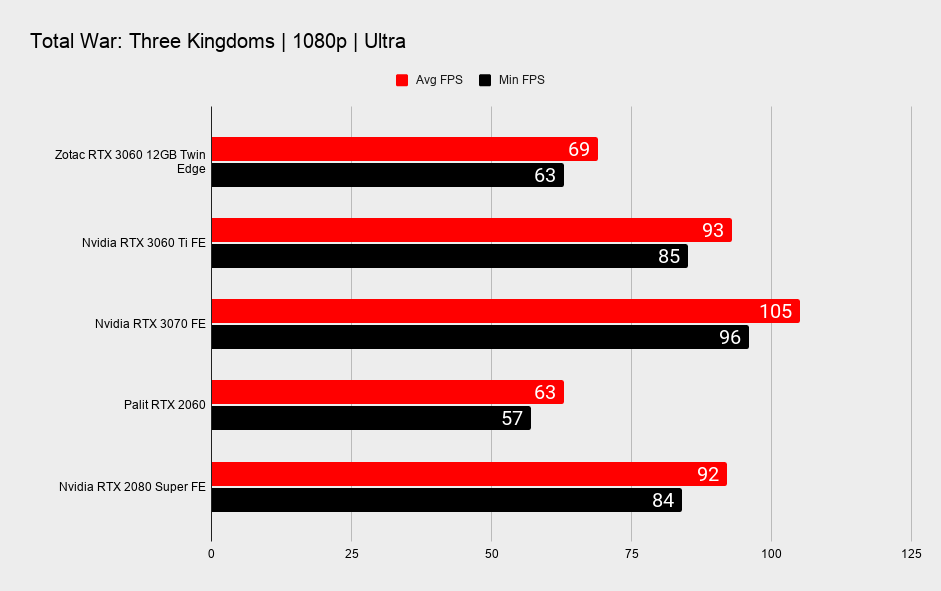
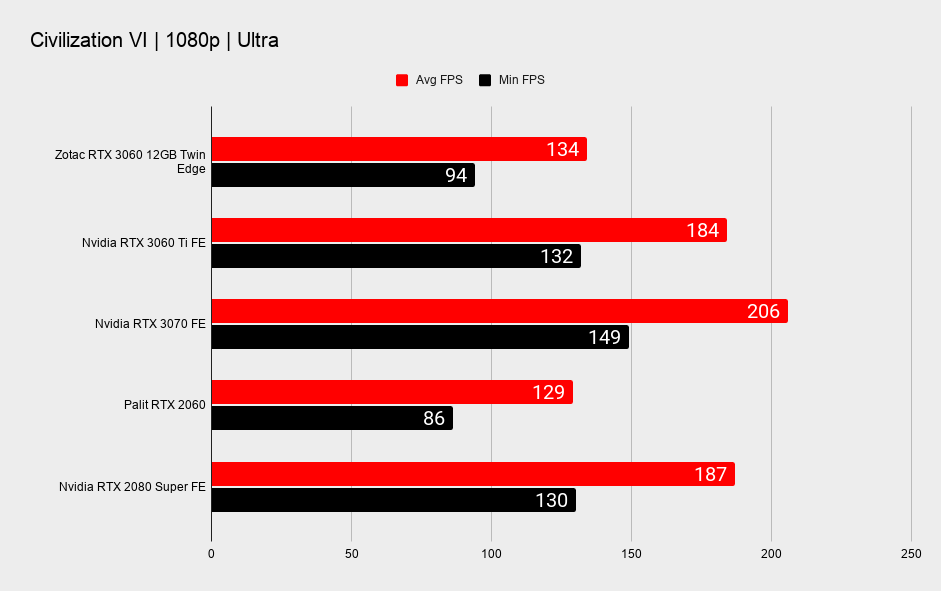
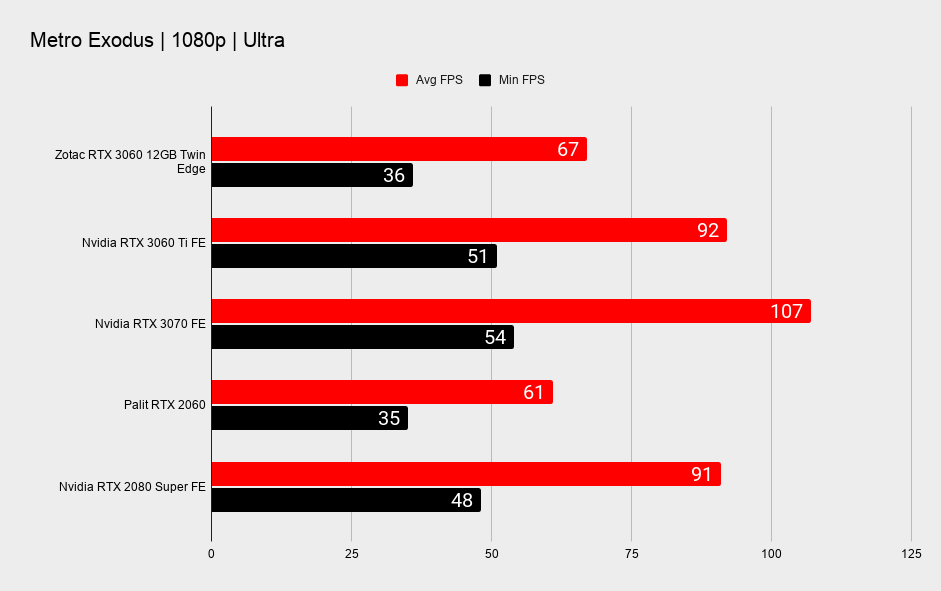
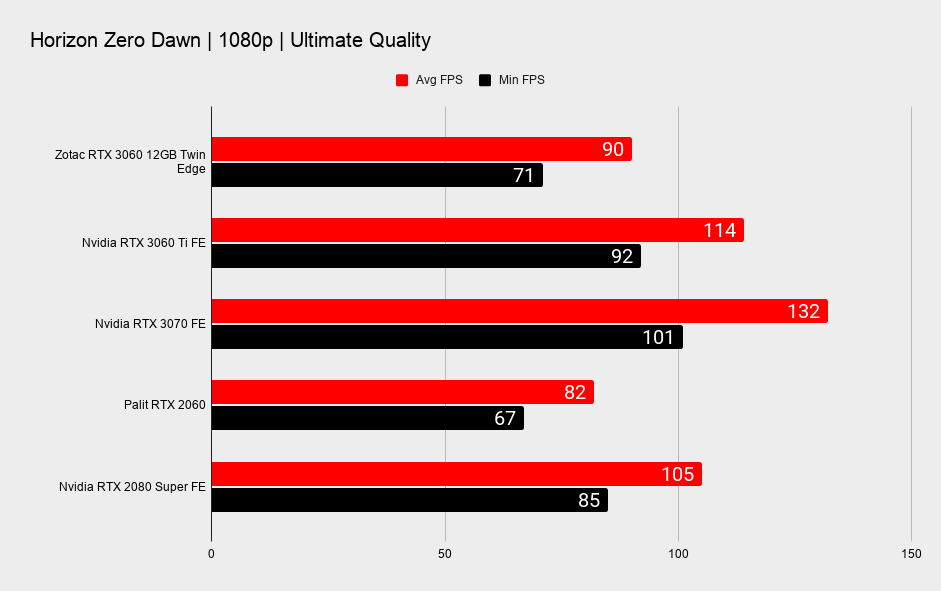
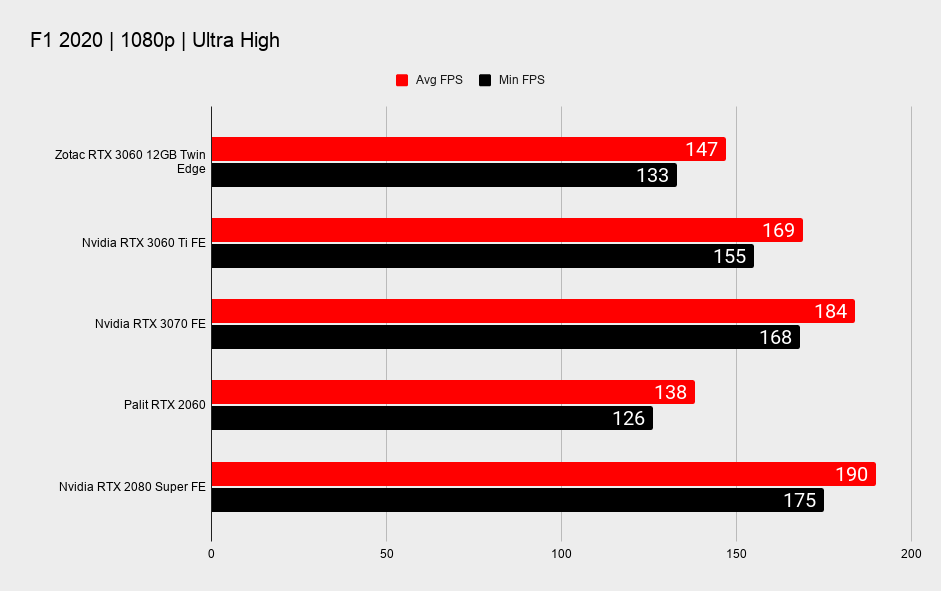
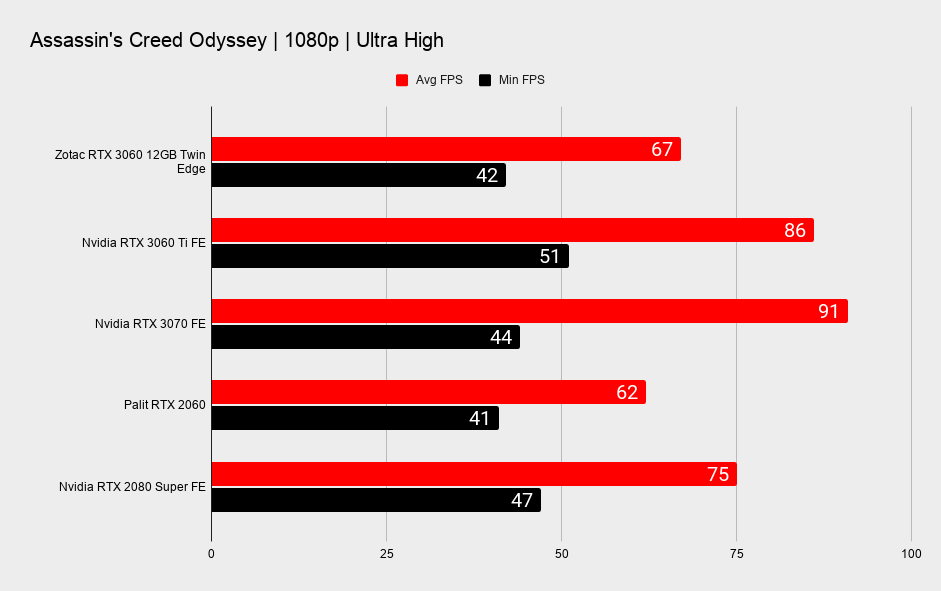
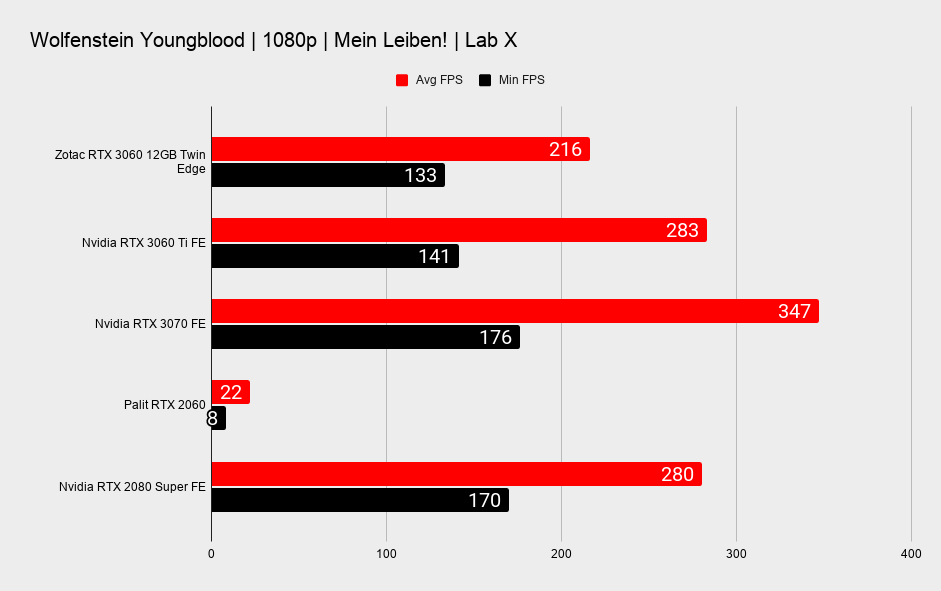

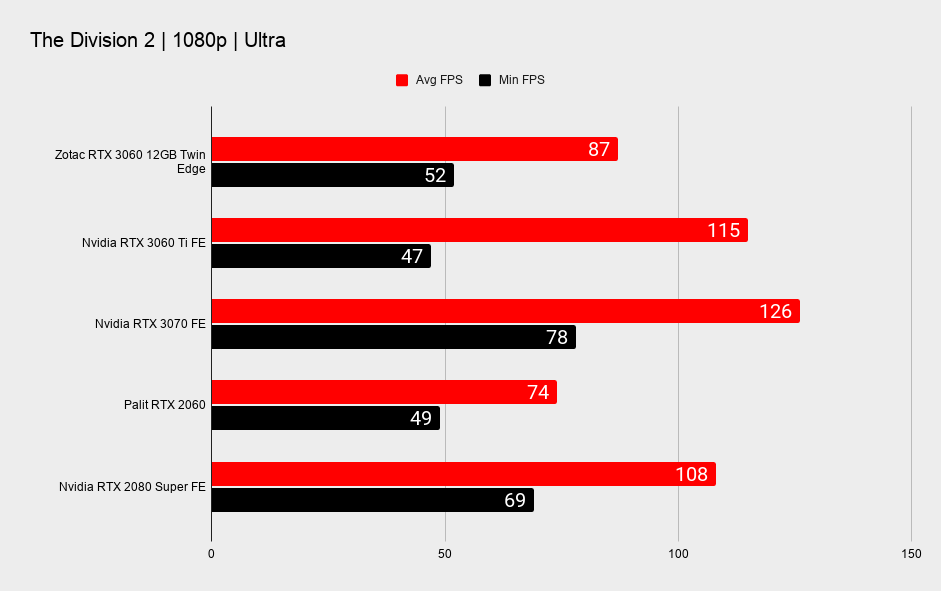
1440p gaming performance
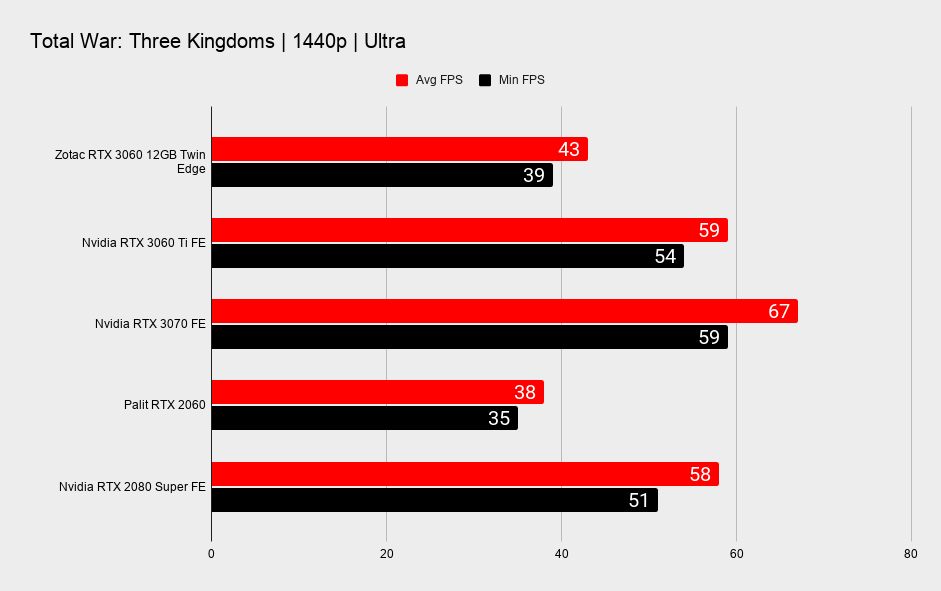
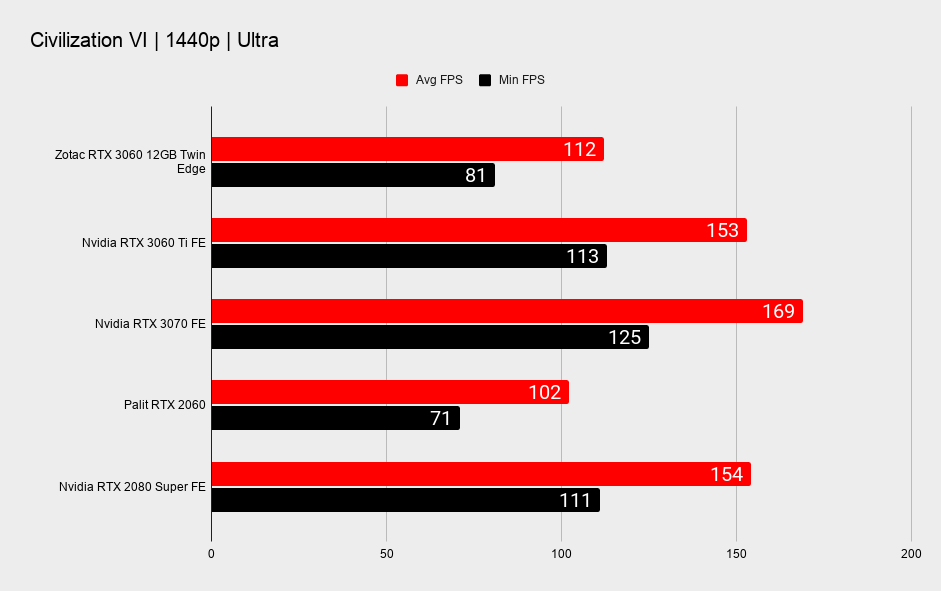
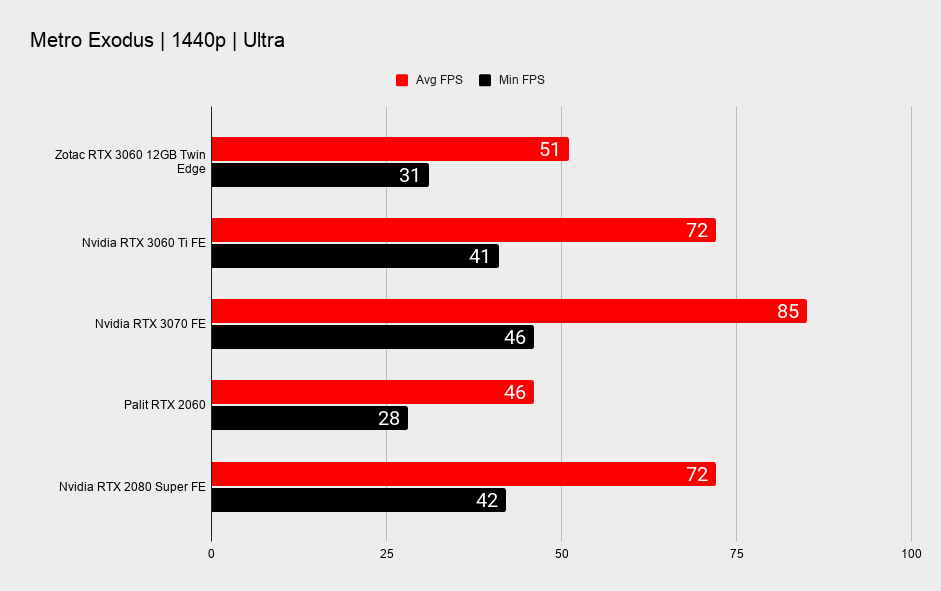
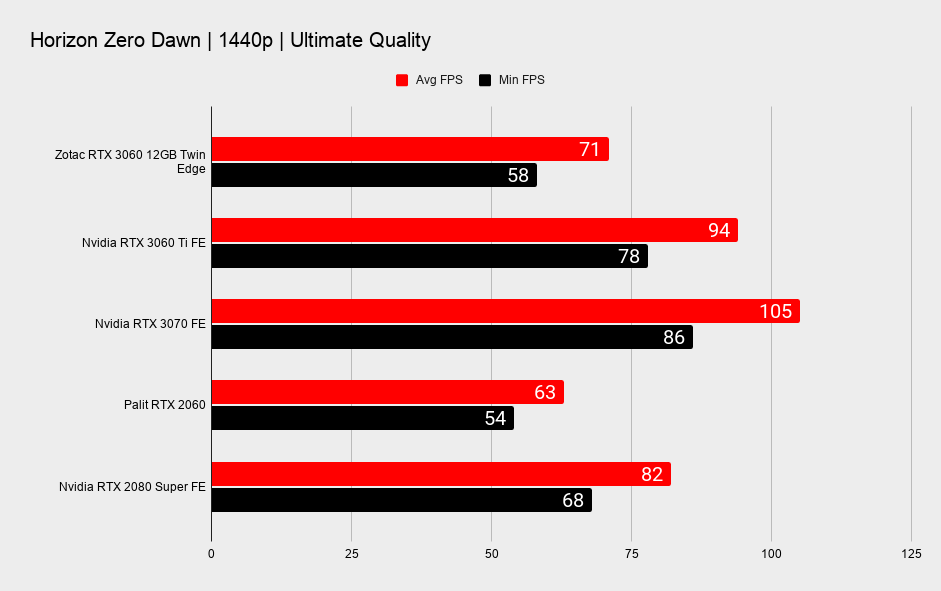
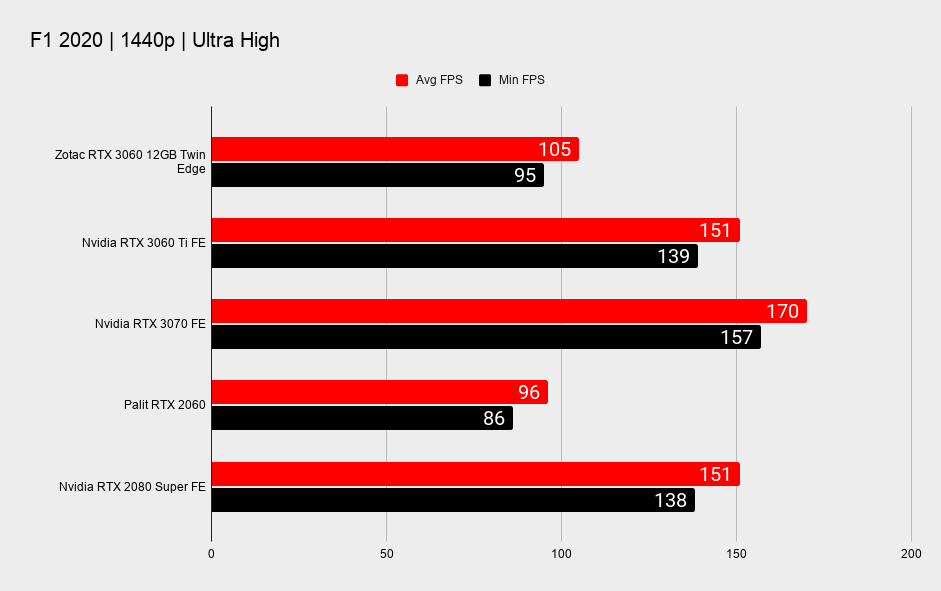

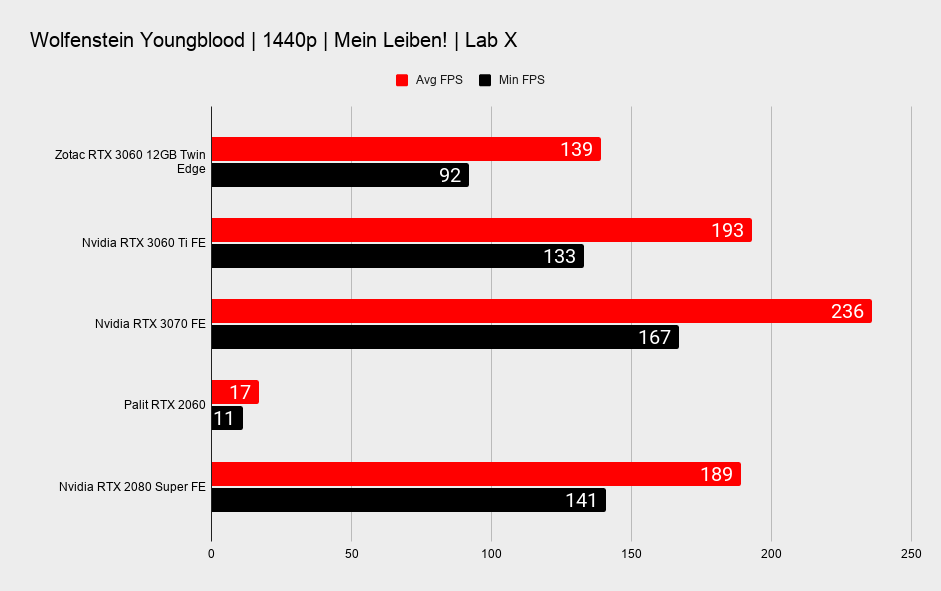
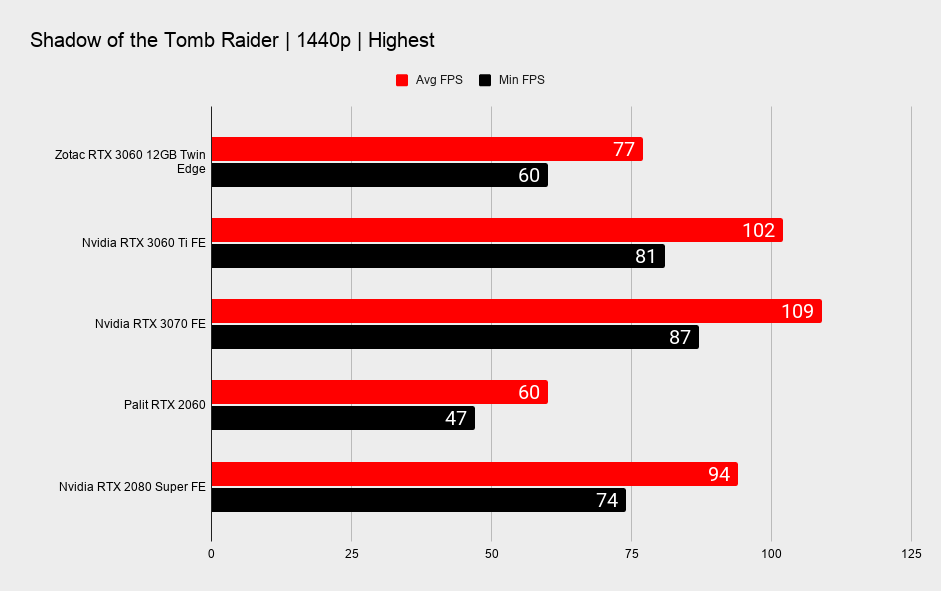
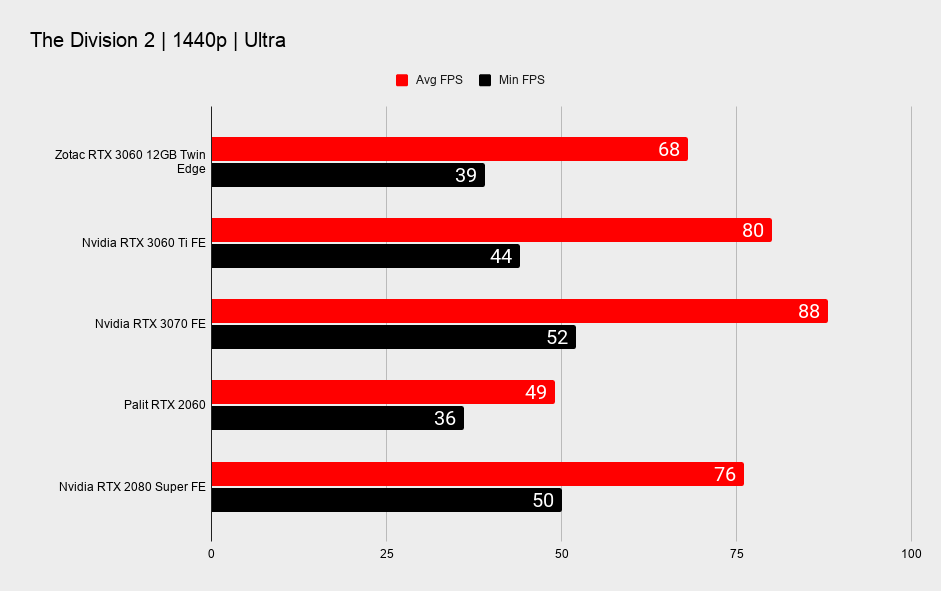
4K gaming performance
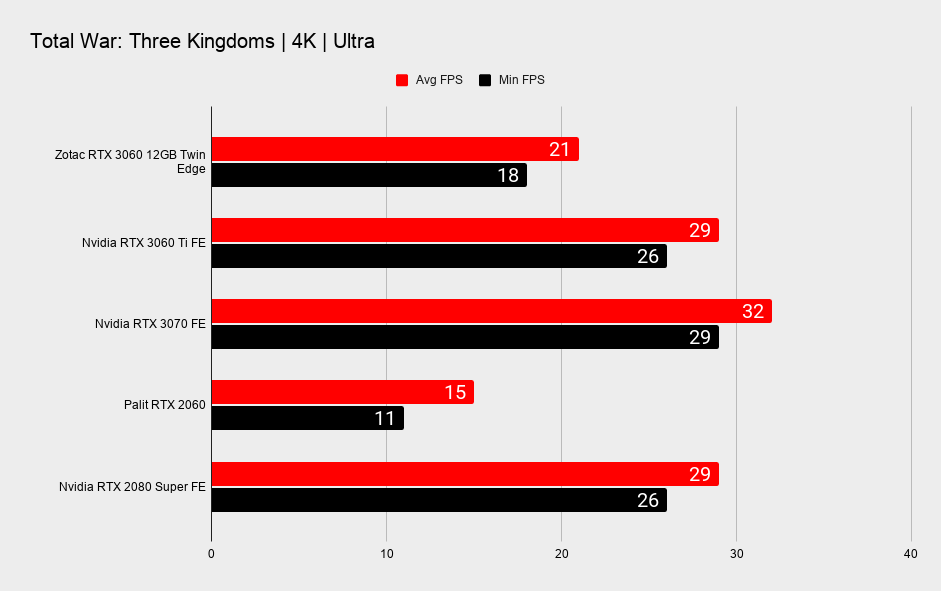
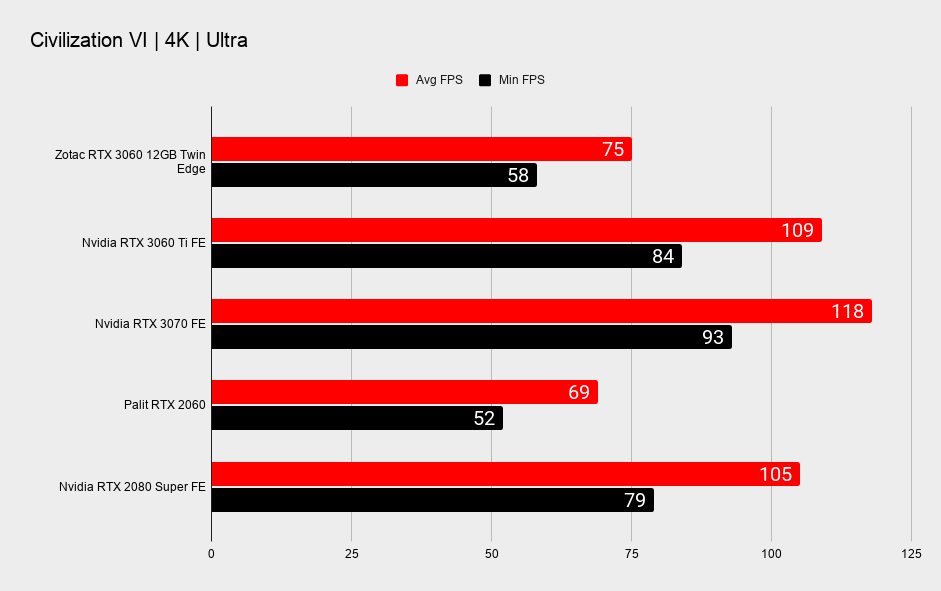
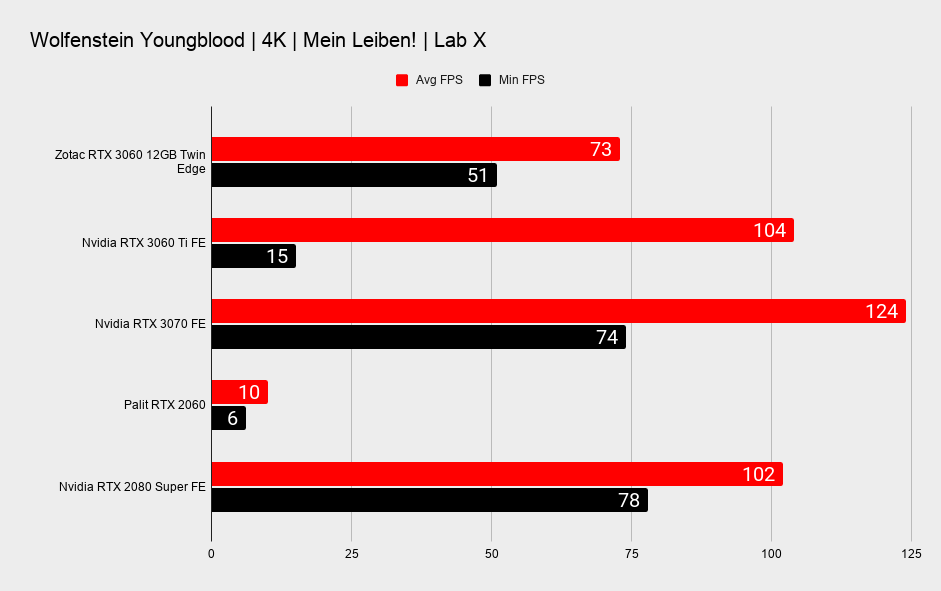
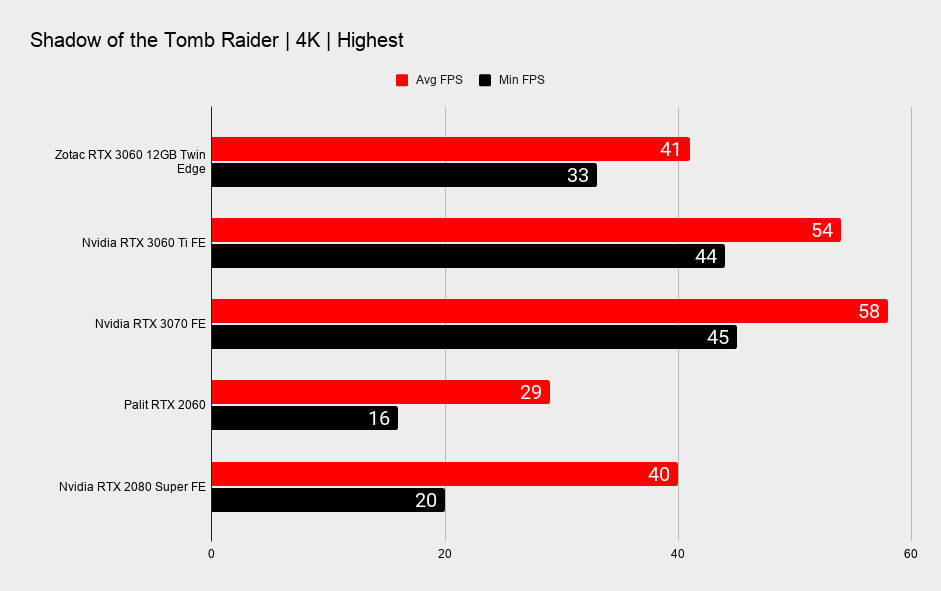
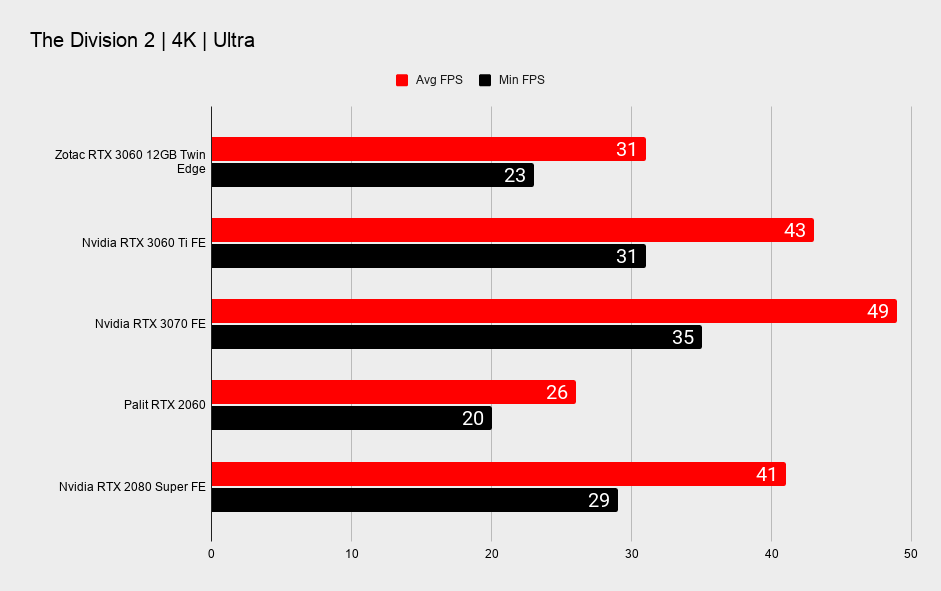
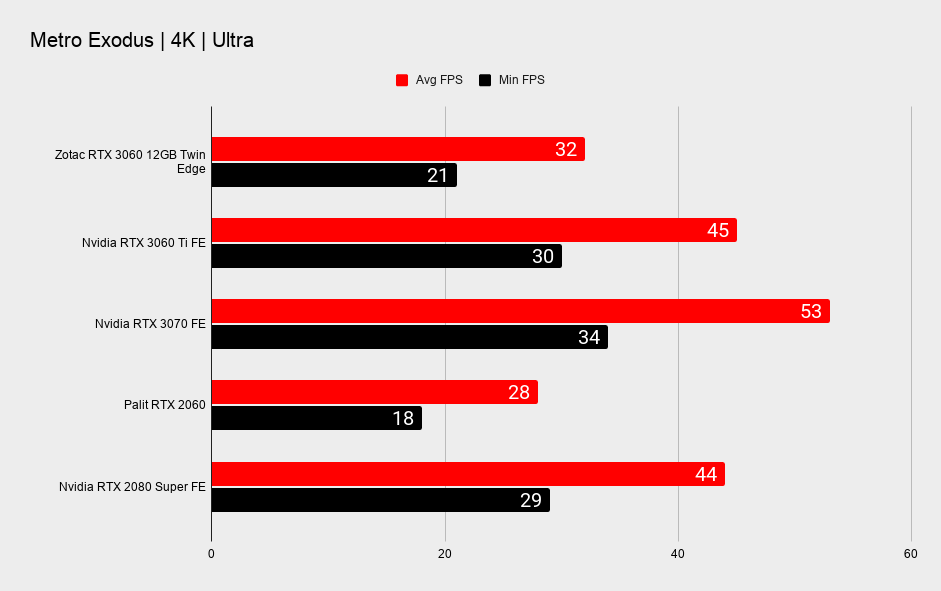
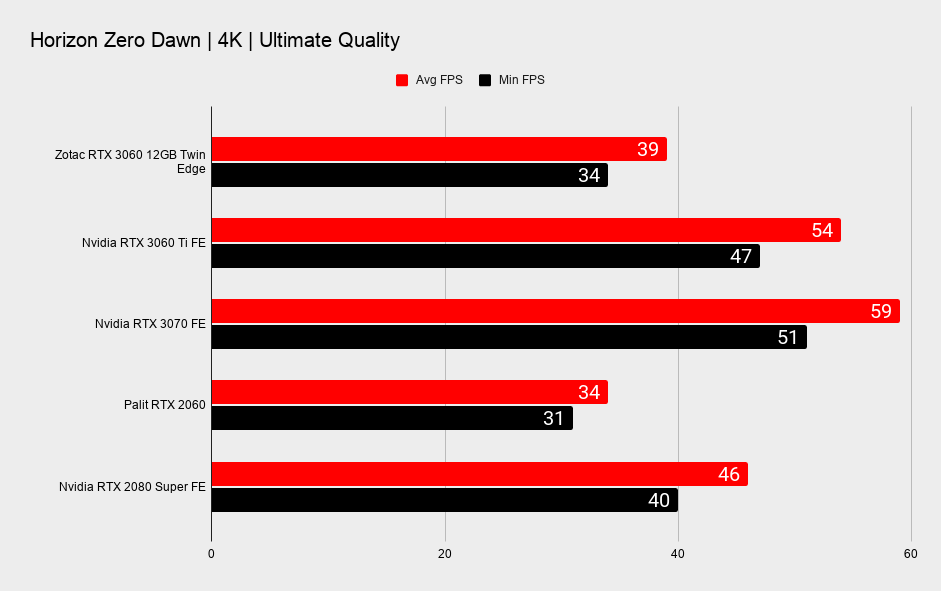
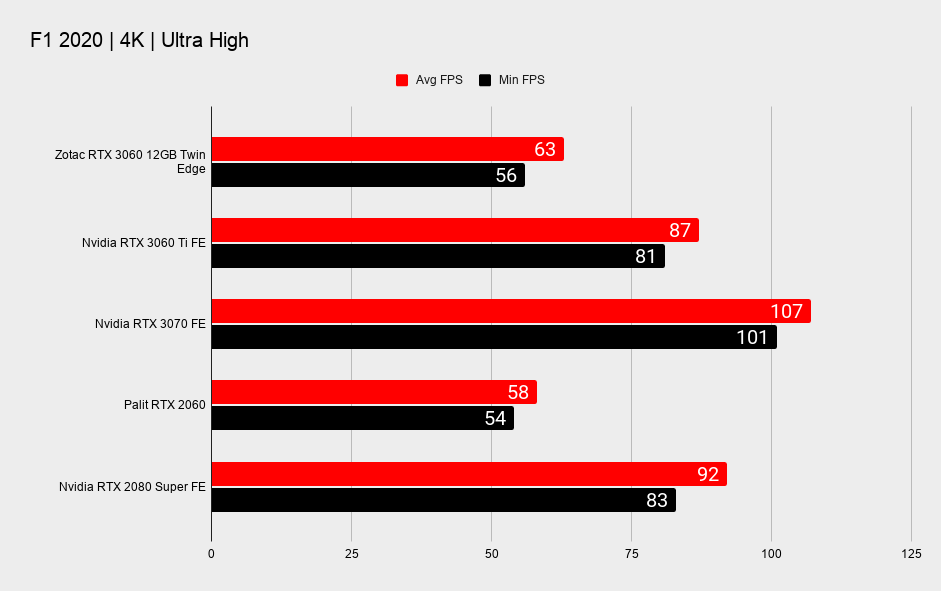
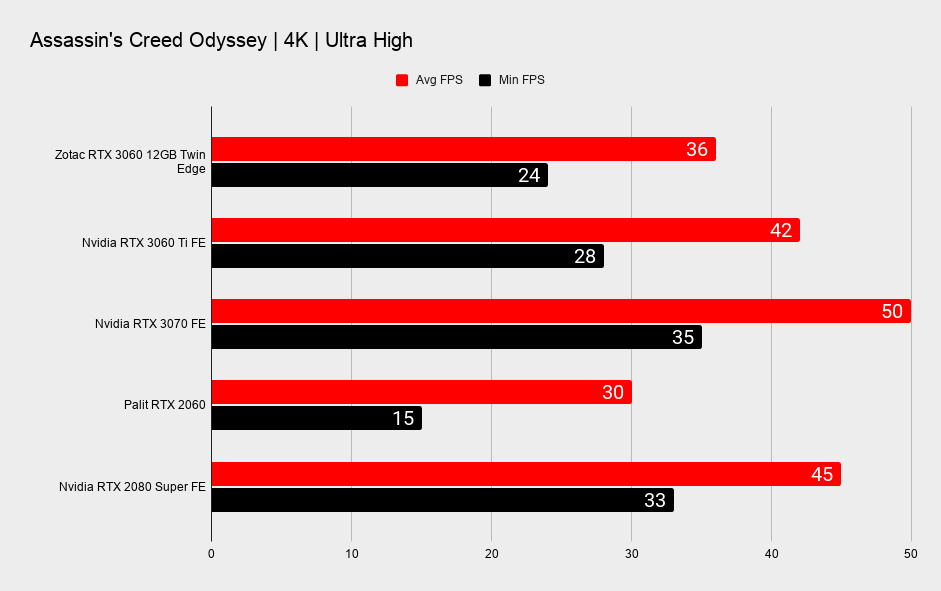
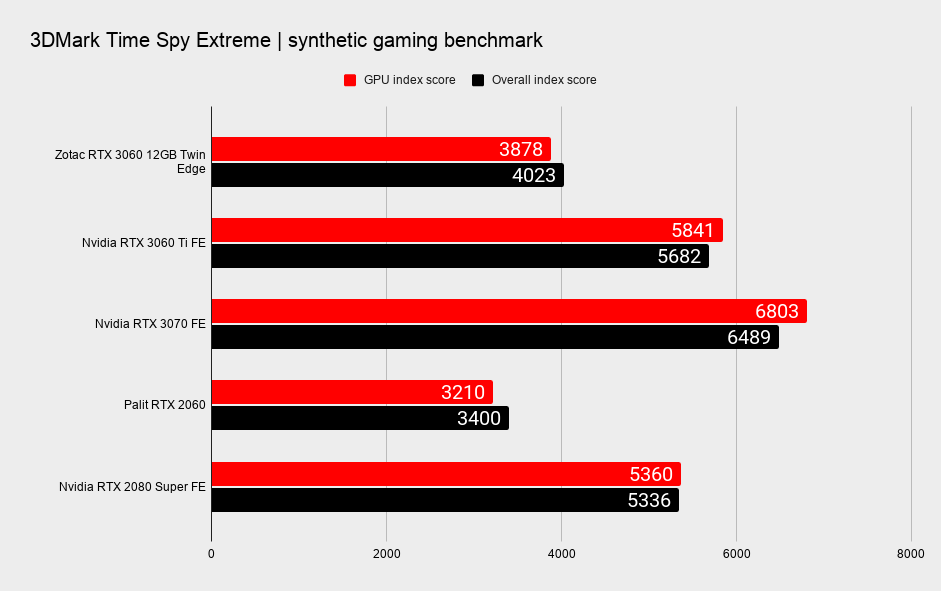
CPU: Intel Core i7 10700K
Motherboard: MSI MPG Z490 Gaming Carbon WiFi
RAM: Corsair Vengeance RGB Pro @ 3,200MHz
CPU cooler: Corsair H110i RGB Pro XT
PSU: NZXT 850W
Chassis: DimasTech Mini V2
Assassin's Creed: Odyssey at ultra high continues to kill off hopes of a stable 60fps on a budget—there's clearly more work to be done to trivialise that game at full whack. That's sure to be even more pronounced on a weaker CPU, which this title can be particularly punishing of.
Similarly, Metro Exodus appears a pain point for the RTX 3060, whereas the RTX 3060 Ti manages to retain slightly more optimistic performance at both 1080p and 1440p. In fact, if you look across our results you'll find the RTX 3060 Ti dominating by 20-40%. Another reason why that card is a great buy at $399.
With no direct competitor from AMD just yet, it's mostly Nvidia's own Turing generation that we have to pit this card against.
The RTX 3060 12GB bounces around 10-15 percent improvement on the RTX 2060 across the board, though that can swing drastically on a per-game basis. In The Division 2 the RTX 3060 can be upwards of 20-40 percent quicker.
Ray tracing and DLSS performance
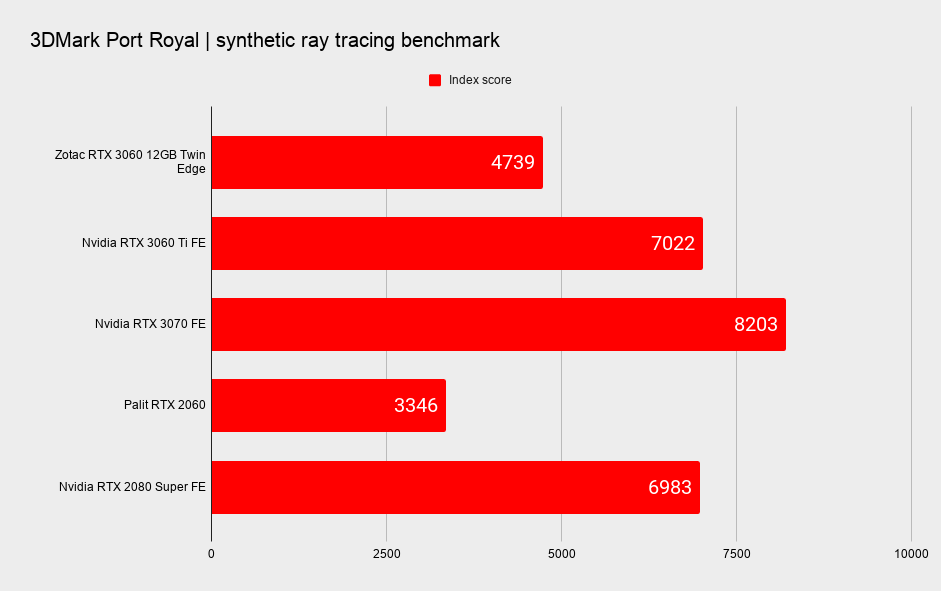
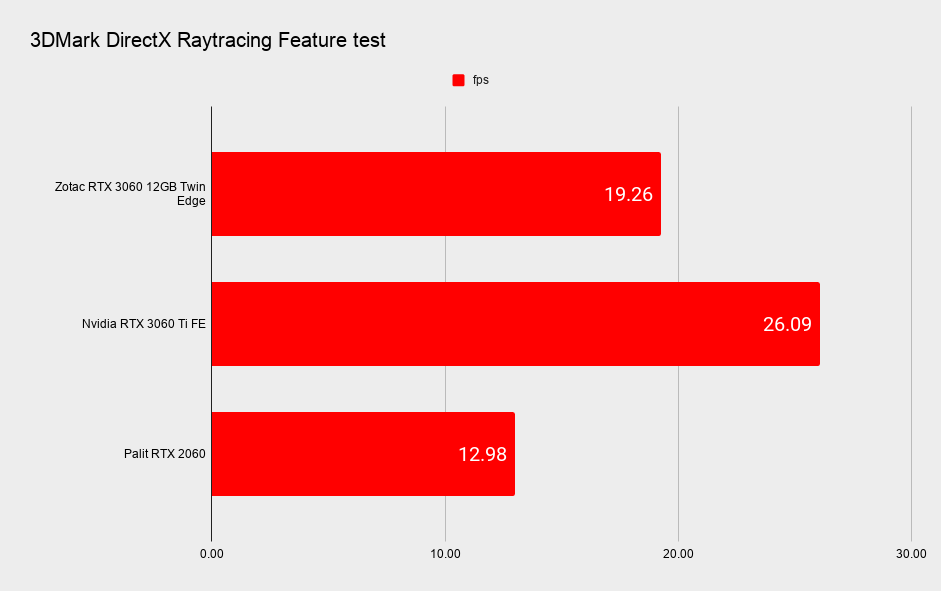
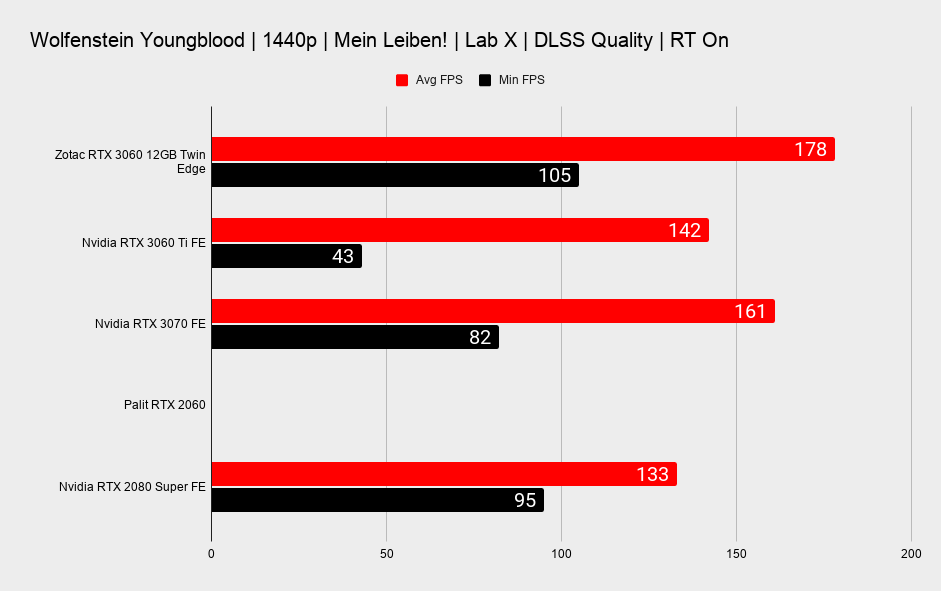
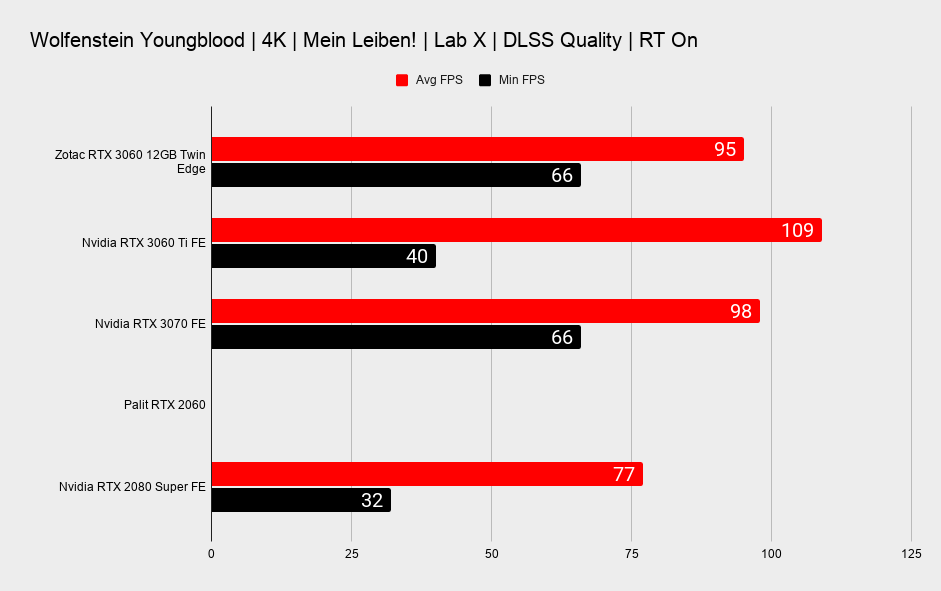
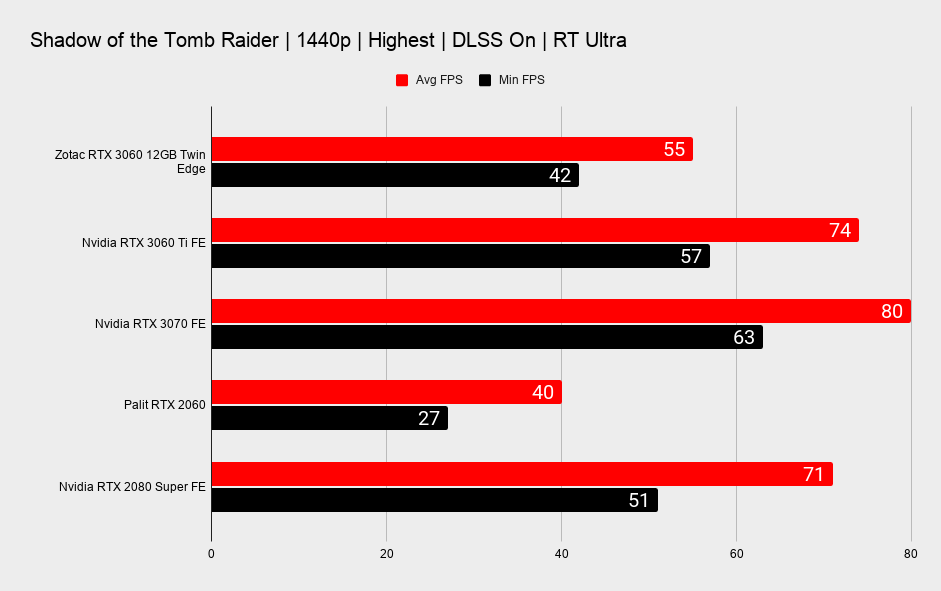

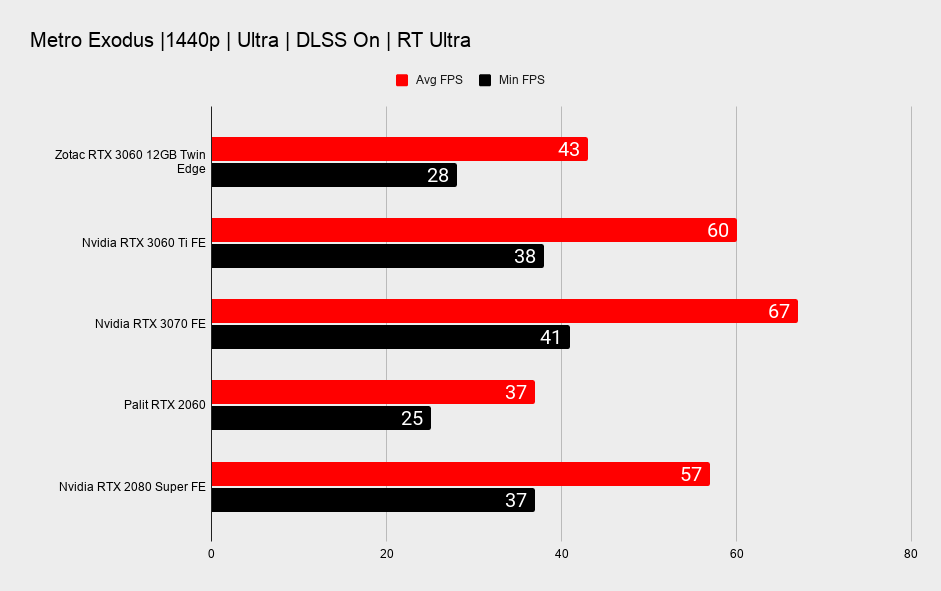
How much of an impact that 12GB of VRAM is having on 1080p and 1440p performance is nebulous and tough to track, but it appears to have had some impact at 4K, where frame rates look a little more favourably on the RTX 3060 12GB.
Power and thermals
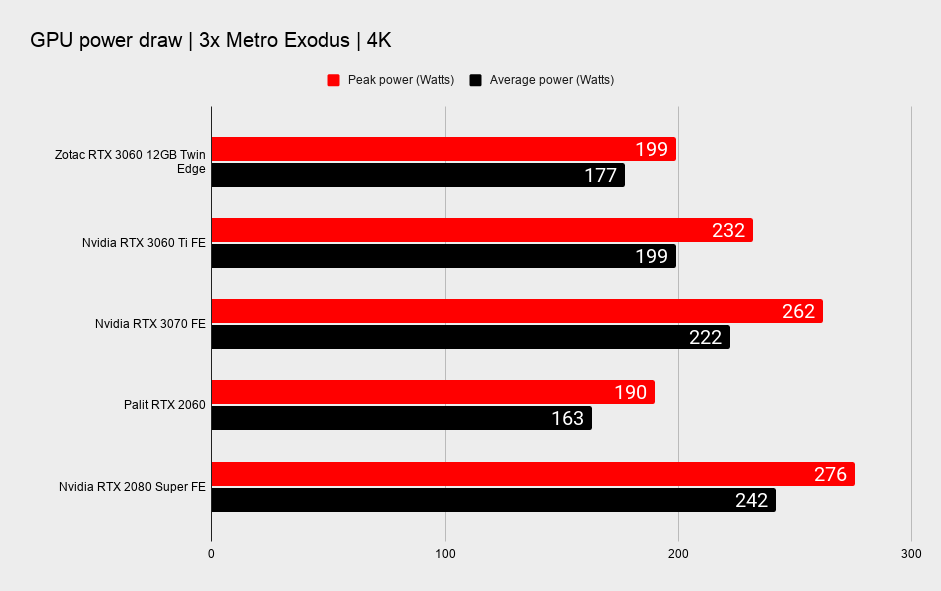
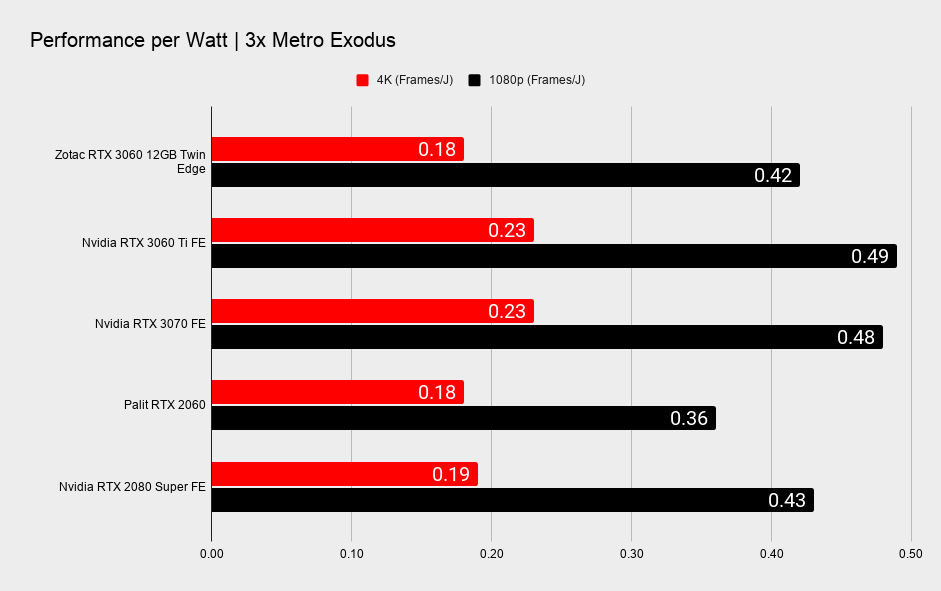
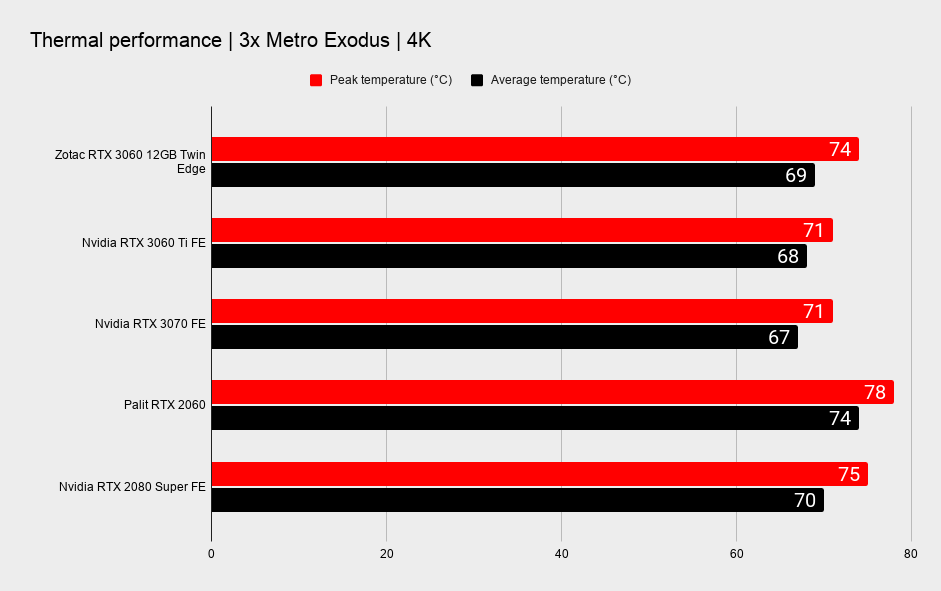
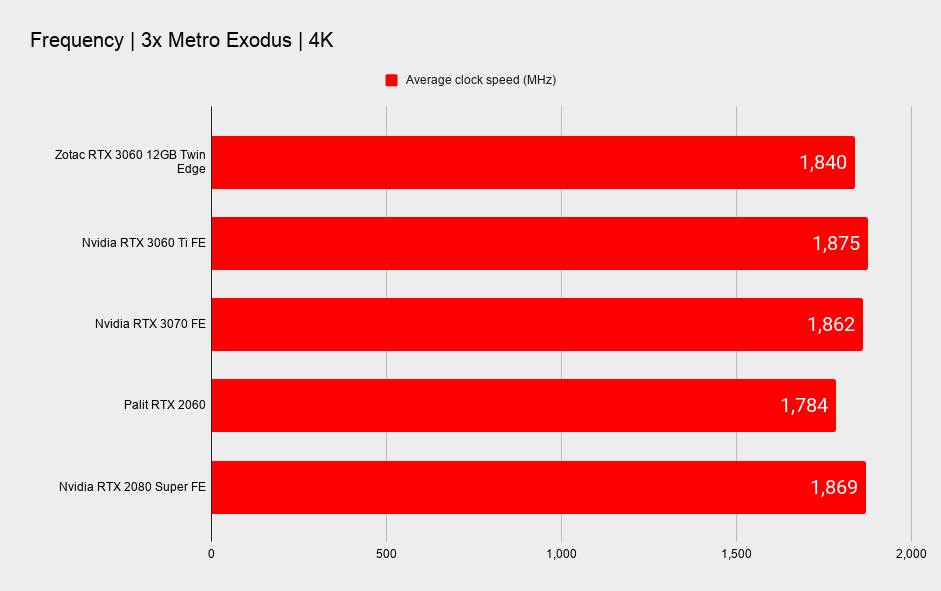
It's at greater resolutions where the memory capacity will be tried and tested the most, and if it's not Nvidia's silicon then it's that 12GB of memory that's making the difference. We're still not seeing a massive upheaval in every game, though, suggesting that gaming demands for memory still aren't creakingly high for even a 6GB card like the RTX 2060.
Analysis

What does the Nvidia RTX 3060 12GB mean today?
At first glance the Nvidia RTX 3060 12GB may appear off kilter, even top heavy, with a bulbous memory configuration and a slimline GPU. Yet the card delivers performance upwards of the RTX 2060 by a decent margin, while arriving cheaper, and with enough zeal at 4K to make me believe that 12GB of GDDR6 may have some effect even with limited bandwidth.
Questions regarding memory supply will no doubt be raised in response to the generous dollop of GDDR6 with the RTX 3060, but when we know very little of a supply chain that Nvidia has close command over, you can only assume it believes it to be a realistic goal.
Will the RTX 3060 12GB eventually give way to a 6GB version as the year stumbles on? It's something to keep an eye on, at least.
I am sure that a sub-$300 card with less memory would be a welcome addition to the stack, however, even if 6GB does feel a little too meagre for even a mid-range graphics card by today's standards.
That 12GB of GDDR6 certainly feels more comfortable for the ephemeral concept of future-proofing
Nvidia has priors in reducing core count alongside alternate memory configurations, though, even when two cards share the same name. Take the 6GB and 3GB GTX 1060 graphics cards, for example, the latter of which you could argue is hardly a GTX 1060 at all.
Another question that's burning in the back of my mind is would the RTX 3060 have performed nearly as well with only 6GB of GDDR6? I dare say it probably would, for a while... that could well be underestimating how swiftly the tide may turn on VRAM demands in gaming, and the effect that little digit before 'GB' has on your average consumer's purchasing habits.
Few games currently require large memory buffers at anything less than 4K resolution, but that may change rather rapidly. As we're already beginning to experience even today.
While relatively few in number, there are some games today that do require more than 6GB of VRAM at high fidelity settings. Wolfenstein: Youngblood struggles to run at Mein Leben! (highest) quality on the RTX 2060's 6GB of GDDR6. That's not a problem I remember having in the past with older versions of the game, but it's repeatable, so clearly something's sent this card over the edge and into oblivion.
That's a bit of a niche case, granted, and you could quite easily crank down the graphics fidelity for just as enjoyable a time. But is even one game rendered unplayable due to a lack of video memory enough to justify a 12GB card? For many, I would imagine it is.
It certainly will strike fear into anyone eyeing up a 6GB card in 2021. It's almost impossible to say when and to what extent the shift to greater memory demands will come about, but be sure that memory demand will increase with every new cutting-edge game.
That 12GB of GDDR6 certainly feels more comfortable for the ephemeral concept of future-proofing.
It's those of us rocking GTX 1060 and older graphics cards that Nvidia is hoping to get on board with the RTX 3060, and it certainly makes a lot of sense for those on Pascal or older to make the leap to Ampere.
As a short hop for an RTX 2060 owner? Perhaps not. There's just not the upgrade there to warrant the investment. Even with improved performance across both rasterised and ray-traced workloads.
That is unless you're prepared to sell off your second-hand card to a miner for something close to what you paid for it two years back. Stranger things have happened… but that all relies on you managing to snag an RTX 3060 first, and I have no doubts that, even with significant stock at hand, these cards will be hard to come by.
Nvidia hopes to ease the launch day scramble by taking this particular card off the table for Ethereum, which is by far the most popular cryptocurrency for GPU mining. A three-way handshake between vBIOS, driver, and silicon ensures a halving of the hash rate when an Ethereum mining algorithm is detected, and it is confident that it's not going to be circumvented.
That's at least some heat off the RTX 3060's availability, but I fear there's nothing anyone can do to satiate the hungry GPU market today except keep the silicon pumps at full speed and chips flying out to retailers as fast as they can.
Verdict
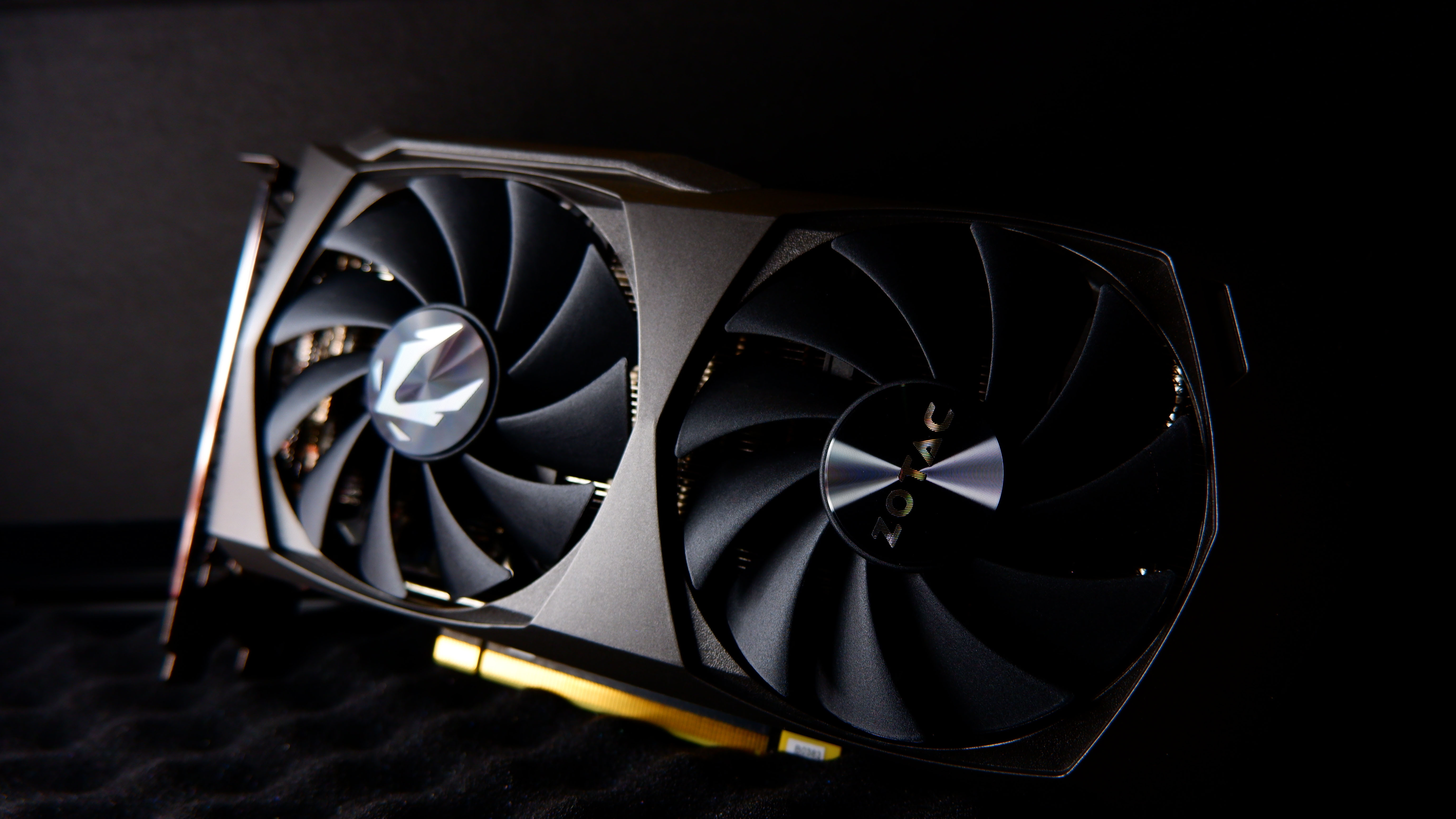
Conclusions
The RTX 3060 delivers a healthy performance gain over the RTX 2060 and a lower asking price on launch day.
That is admittedly more of a small hop compared to the generational leap we've come to expect from the Ampere RTX 30-series, and perhaps that's why the RTX 3060 12GB release has not shaken my resolve on the RTX 3060 Ti being a great buy. For $70 more you get that greater memory bandwidth, that bounding performance gain we've come to expect, and all the net benefits of the Ampere architecture.
That's also likely $70 that will be chewed up by premium third-party cards and factory overclocked RTX 3060s with a high sticker price.
For my money, then, I'm sticking with the RTX 3060 Ti as the mid-range champion. The Nvidia RTX 3060 strays a little too far from the pack of high-end Ampere to have the same impact generation on generation. But in that same breath it must be said that the RTX 3060 a fine upgrade for a 10-series or older card, especially if it stays anywhere close to MSRP, and one that will likely see you confidently through the next few years of major game releases.
A healthy upgrade over the RTX 2060, but a little of the wow factor has worn off for Ampere's cheapest. You can at least be confident that you won't run out of memory, at least, and that feels like it will be important for gaming into 2021 and beyond, even if we're not quite there yet.

Jacob earned his first byline writing for his own tech blog. From there, he graduated to professionally breaking things as hardware writer at PCGamesN, and would go on to run the team as hardware editor. He joined PC Gamer's top staff as senior hardware editor before becoming managing editor of the hardware team, and you'll now find him reporting on the latest developments in the technology and gaming industries and testing the newest PC components.
